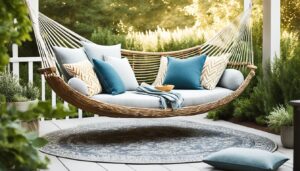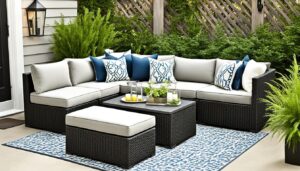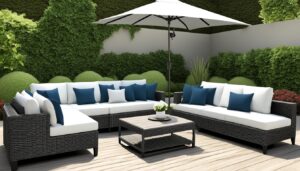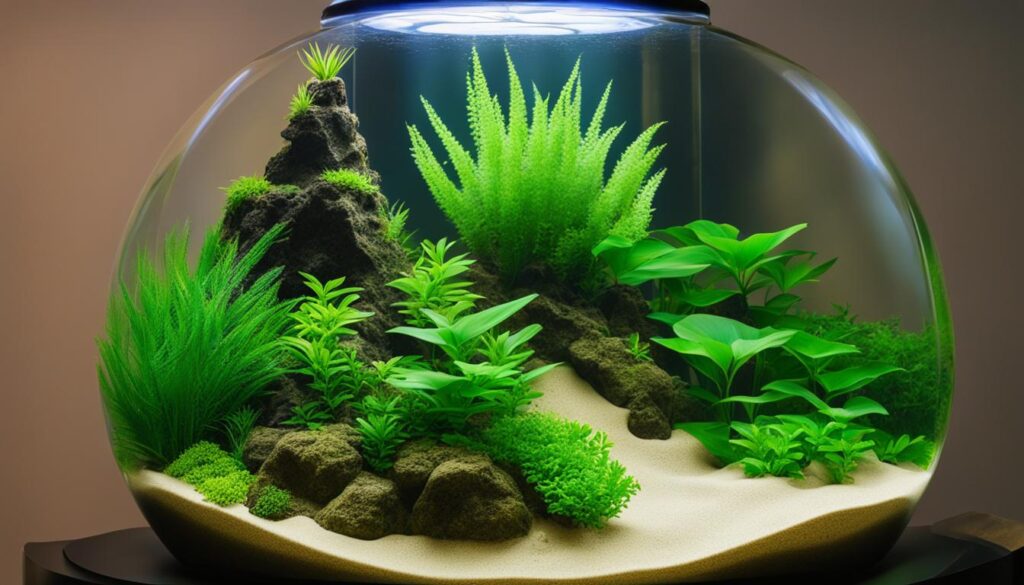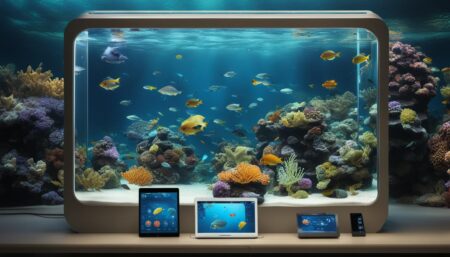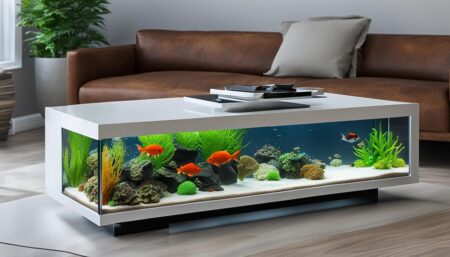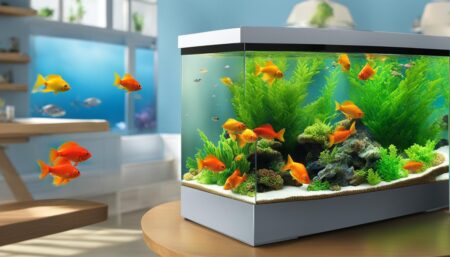Aquarium plants add beauty and natural balance to any aquatic environment. Many hobbyists wonder if plants can grow in sand aquariums, considering the unique challenges presented by this substrate. In this article, we will explore whether plants can thrive in sand aquariums, the challenges they face, the benefits of using sand as a substrate, and the best plant options for sand aquariums.
Key Takeaways:
- Plants can grow in sand aquariums, but they face challenges due to the lack of nutrients in the substrate.
- Proper care, including the use of root tabs and nutrient supplementation, can help plants thrive in a sand substrate.
- Sand substrates offer design versatility and a natural look in the aquarium, particularly in biotope setups.
- Some plant species, such as Cabomba, Dwarf Hygro, and Java Fern, are well-suited for growing in sand substrates.
- Maintaining stable water parameters and providing adequate lighting and liquid fertilizer are essential for successful plant growth in sand substrates.
Challenges of Growing Plants in Sand Substrate
Growing plants in sand substrate presents several challenges that aquarists need to consider. The density of sand makes it difficult for plants to anchor their roots, leading to issues with stability and floating plants. Additionally, sand is not a nutrient-rich substrate, which can result in nutrient deficiencies for the plants. These challenges can hinder the growth and overall health of aquarium plants in a sand substrate.
Root anchoring: The density of sand makes it challenging for plants to establish a strong root structure. Without sturdy roots, plants may easily become uprooted and float freely in the water column. This can disrupt the overall aesthetic and stability of the aquarium.
Nutrient deficiency: Unlike aqua soil, sand is not a nutrient-rich substrate. Plants rely on these essential nutrients, such as nitrogen, phosphorus, and potassium, for their growth and development. Without adequate nutrients, plants may exhibit stunted growth, yellowing leaves, or even die off.
To overcome these challenges and promote plant growth in a sand substrate, aquarists can employ several strategies. The use of root tabs, which are fertilizers specifically designed for root absorption, can help provide necessary nutrients to the plants. Additionally, regular supplementation with liquid fertilizer can help ensure that plants receive the nutrients they need. Finally, maintaining proper lighting conditions and water parameters will support the healthy growth of plants in sand substrates.
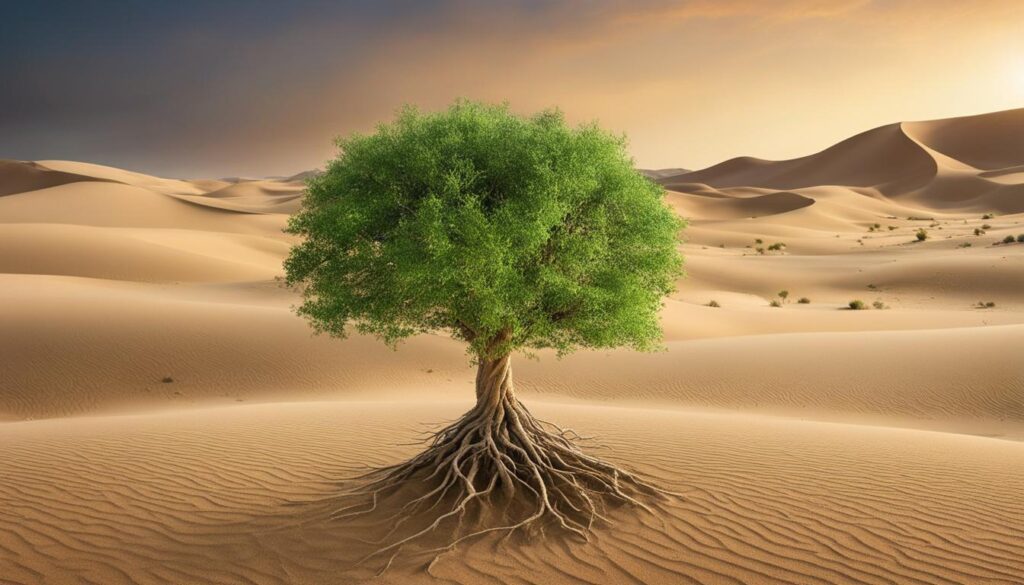
| Challenges of Growing Plants in Sand Substrate | Solutions |
|---|---|
| Root anchoring difficulties | Use plants with strong root systems, such as Cryptocoryne, and provide stability with rocks or driftwood |
| Nutrient deficiency | Use root tabs for nutrient supplementation and regularly dose liquid fertilizer |
| Stunted growth and yellowing leaves | Maintain proper lighting conditions and water parameters, including temperature and pH |
Benefits of Using Sand as a Substrate
Using sand as a substrate in aquariums offers several benefits that make it a popular choice among fishkeepers. Whether you are creating a biotope aquarium or simply prefer the natural look of sand, there are advantages to be gained by using this type of substrate.
One of the main benefits of sand is its lighter weight compared to other substrates like gravel or aqua soil. This makes it easier to work with and allows for more versatility in designing your aquarium. You can create intricate patterns or replicate natural riverbeds with ease, giving your tank a unique and visually appealing aesthetic.
Sand also provides a natural and realistic look, especially in biotope aquariums where you want to mimic the natural habitat of your fish. Many fish species, such as Corydoras, are bottom-dwellers that rely on a sandy substrate for their natural behaviors. By using sand, you can recreate their natural environment and promote their well-being.
| Benefits of Using Sand as a Substrate |
|---|
| Lightweight and versatile |
| Natural and realistic look |
| Suitable for fish with specific substrate requirements |
Sand also has the added benefit of being easier to clean compared to other substrates. Waste and debris tend to sit on top of the sand rather than sinking into it, making it easier to siphon during regular maintenance. This helps to maintain water quality and prevent the buildup of harmful substances in your aquarium.
Overall, using sand as a substrate can provide a beautiful and natural-looking environment for your aquarium. It offers versatility in design, suits the substrate requirements of certain fish species, and is easier to clean. Consider these benefits when choosing the substrate for your next aquarium setup.
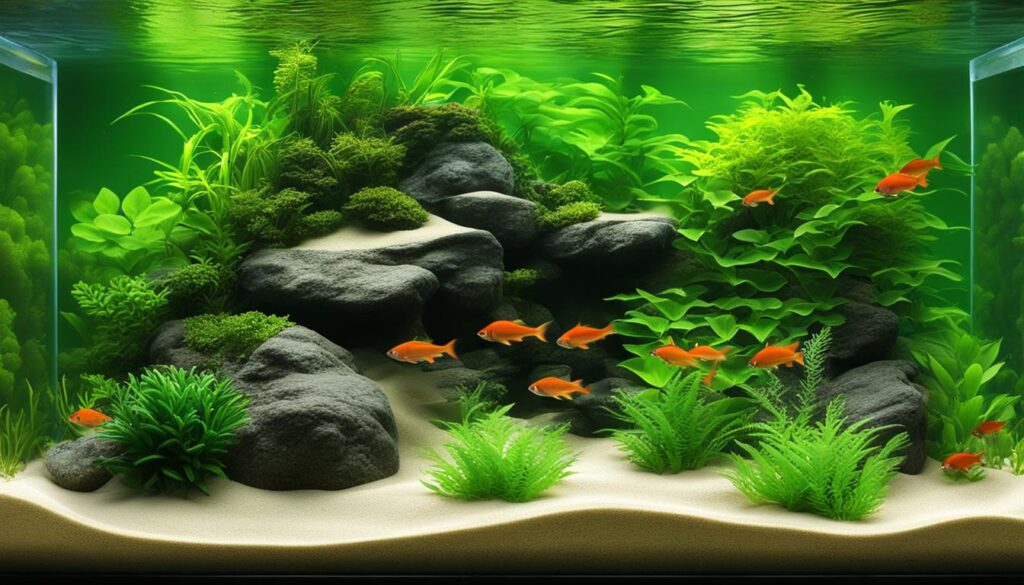
Plants Growing in Sand Substrate in Nature
Plants have evolved to grow in various types of environments, including sand substrates. In nature, plants can be found thriving in river beds where the soil, gravel, and sand create a nutrient-rich environment for growth. These areas provide plants with the necessary nutrients and stability to establish strong root structures and flourish.
In tropical regions, dry seasons often lead to the formation of bare ground or grassy fields with sandy soil. Despite the lack of traditional substrate, plants adapt and grow in these sandy environments. Their ability to absorb water and nutrients from the air and surrounding water column allows them to survive and thrive even in sandy conditions.
By replicating these natural conditions in an aquarium with a sand substrate, it is possible to support the growth of plants. Providing the appropriate care, including nutrient supplementation and proper lighting, can help plants adapt to the sand substrate and establish a healthy root system.
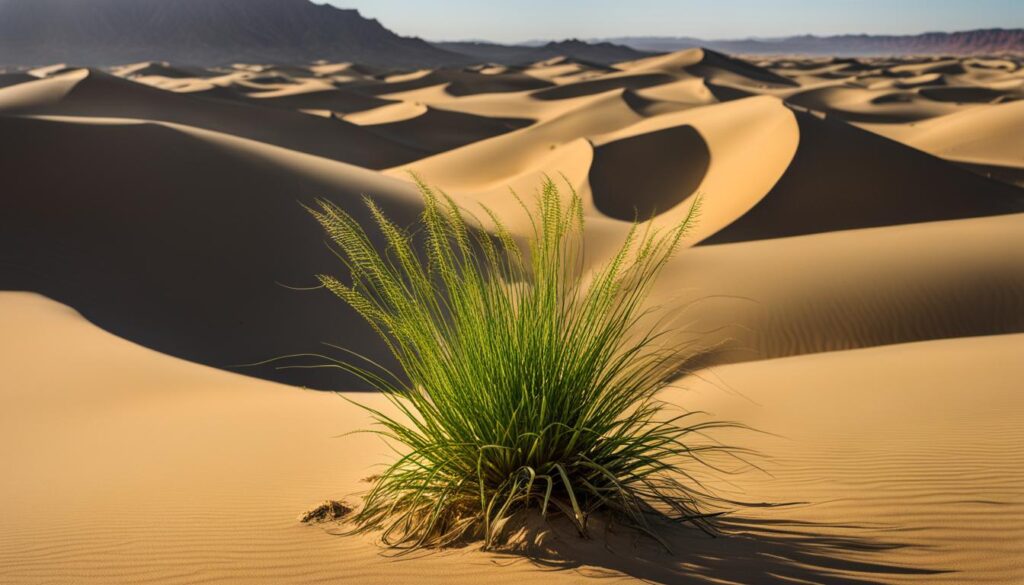
Table: Examples of Plants Growing in Sand Substrates in Nature
| Plant Species | Natural Habitat |
|---|---|
| Anubias Barteri | River beds, streams |
| Java Fern | Forest floors, river banks |
| Vallisneria | River beds, lakes |
Taking Inspiration from Nature
Nature provides valuable insights into the adaptability of plants in varying environments. The presence of plants growing in sand substrates in the wild demonstrates their resilience and ability to utilize available resources efficiently. By studying these natural habitats, aquarium enthusiasts can recreate similar conditions to support plant growth in sand substrate aquariums.
Easy-to-Grow Plants in Sand Substrate
When it comes to growing plants in a sand substrate aquarium, certain species are known for their resilience and adaptability. These easy-to-grow plants can thrive in the nutrient-poor environment of sand, making them ideal choices for aquarium enthusiasts looking to create a lush and vibrant underwater landscape.
One such plant is the Cabomba, a versatile stem plant that can absorb nutrients directly from the water column. With proper lighting, liquid fertilizer, and CO2 supplementation, Cabomba can flourish in a sand substrate, adding a beautiful touch of greenery to the aquarium. Dwarf Hygro is another excellent choice that can absorb nutrients from the water column. Its smaller roots make it well-suited for growing in sand substrates.
Hornwort and Java Fern are also popular options for sand substrate aquariums. Hornwort is a floating plant that doesn’t require planting in the substrate, making it an easy and low-maintenance choice. Java Fern, on the other hand, can be attached to rocks or wood and thrives in low lighting conditions. Both plants are hardy and can tolerate a wide range of water parameters, making them suitable for beginners.
Table: Easy-to-Grow Plants in Sand Substrate
| Plant | Description |
|---|---|
| Cabomba | A versatile stem plant that absorbs nutrients from the water column. Requires high lighting, CO2 supplementation, and regular liquid fertilizer dosing. |
| Dwarf Hygro | A hardy plant with smaller roots that can absorb nutrients from the water column. Suitable for sand substrates. |
| Hornwort | A floating plant that doesn’t require planting in the substrate. Low-maintenance and suitable for beginners. |
| Java Fern | Can be attached to rocks or wood. Thrives in low lighting conditions and is suitable for beginners. |
With these easy-to-grow plants, aquarists can create a stunning underwater landscape in their sand substrate aquariums. Whether you’re a beginner or an experienced hobbyist, these plants offer beauty and resilience, adding a touch of nature to your aquatic haven.
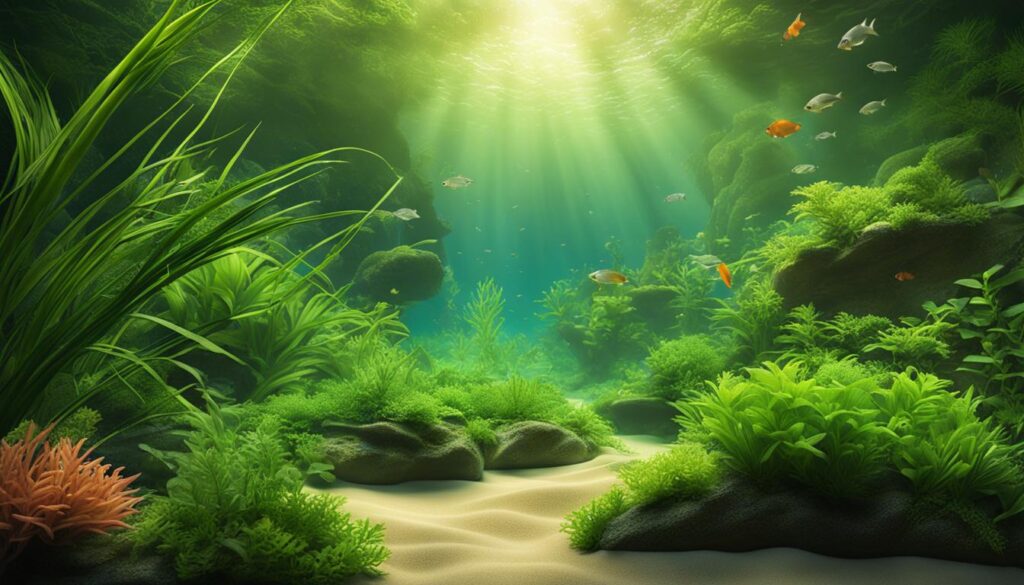
Stem Plants for Sand Substrate Aquariums
When it comes to choosing stem plants for sand substrate aquariums, two excellent options are Cabomba and Dwarf Hygro. These plants not only add beauty and vibrancy to the tank but also have unique characteristics that make them well-suited for growing in sand substrates.
Cabomba, also known as the fanwort, is a South American plant that requires high lighting, CO2 supplementation, and regular liquid fertilizer dosing. Its delicate and feathery foliage creates a stunning visual appeal in the aquarium. With proper care, Cabomba can grow tall and add a lush green backdrop to the tank.
Dwarf Hygro, on the other hand, is a hardy plant with smaller root systems that can absorb nutrients from the water column. It doesn’t require CO2 supplementation and thrives under moderate lighting conditions. Dwarf Hygro’s vibrant green and red leaves create a beautiful contrast in the aquarium and provide a natural feel to the overall setup.
Stem Plants for Sand Substrate Aquariums
| Plant | Lighting Requirements | CO2 Supplementation | Fertilizer Needs |
|---|---|---|---|
| Cabomba | High | Yes | Regular dosing |
| Dwarf Hygro | Moderate | No | Occasional dosing |
Both Cabomba and Dwarf Hygro have the ability to thrive in sand substrates and can enhance the aesthetics of a sand-based aquarium. However, it’s important to remember that these plants may still benefit from the use of root tabs or nutrient-rich aquarium soil to ensure they receive adequate nutrients for optimal growth. Regular pruning and maintenance will also help keep these stem plants in top condition.
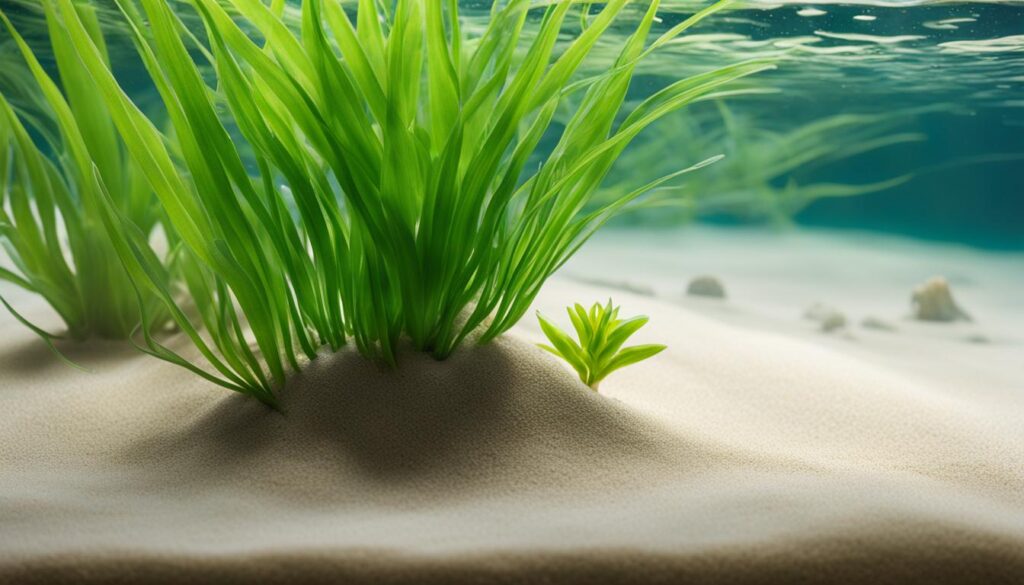
Best Plants for Around the Aquarium
When it comes to creating a stunning aquarium, selecting the right plants for the surrounding areas can make a significant difference in the overall aesthetic appeal. Whether you want to add some greenery to the background or incorporate plants that can attach to rocks or wood, there are several options to consider. Here are some of the best plants for around the aquarium:
Java Fern
Java Fern (Microsorum pteropus) is a versatile plant that doesn’t require planting in the substrate. It can be attached to rocks or wood, creating a natural and visually appealing look. This plant thrives under low light conditions, making it suitable for various aquarium setups. Java Fern also propagates easily, allowing you to expand its presence in your tank effortlessly.
Amazon Swords
Amazon Swords (Echinodorus) are popular choices for background planting due to their bushy appearance and strong root structures. These plants require root tabs for optimal growth as they rely on nutrient absorption from the substrate. Amazon Swords can add depth and texture to your aquarium, creating a lush and vibrant underwater environment.
To further enhance the visual impact, consider incorporating other decorative elements, such as rocks, driftwood, or caves, to provide additional hiding spots and create a natural habitat for your aquatic pets. The combination of these plants and decorations will elevate the overall beauty of your aquarium and provide a more visually appealing and stimulating environment for your fish.
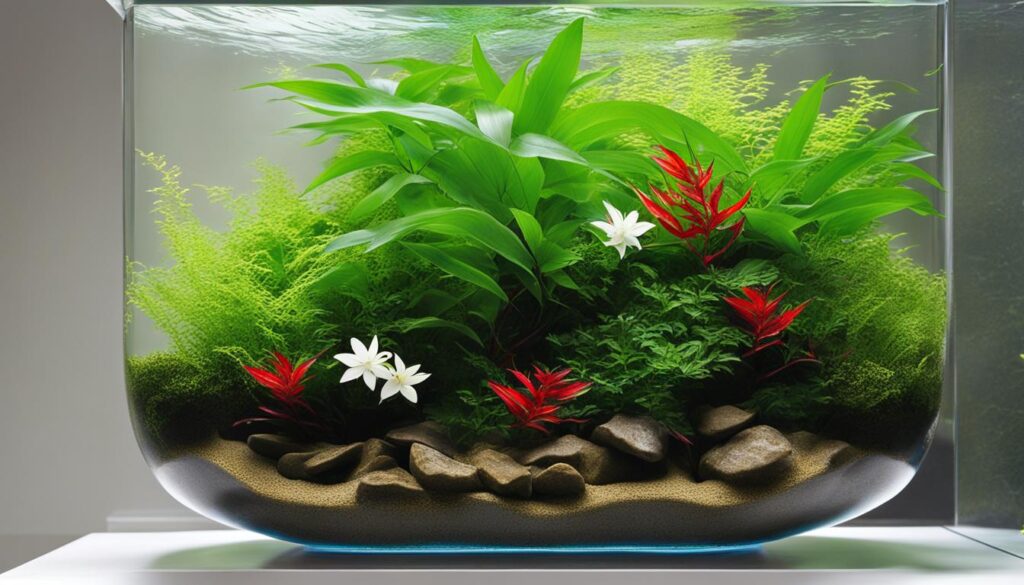
Table: Summary of Best Plants for Around the Aquarium
| Plant | Planting Method | Growth Requirements | Special Considerations |
|---|---|---|---|
| Java Fern | Attach to rocks or wood | Low light | Easy to propagate |
| Amazon Swords | Plant in substrate with root tabs | Moderate light | Bushy appearance |
Cryptocoryne for Mid-Ground Areas
Cryptocoryne plants are an excellent choice for creating a stunning mid-ground area in your aquarium with a sand substrate. These plants have a strong root network that anchors them securely in the substrate, providing stability and structure to the tank. Cryptocoryne plants come in various species and offer a range of colors, from deep greens to vibrant reds, adding depth and visual interest to your aquascape.
One popular species of Cryptocoryne is Cryptocoryne wendtii. It has broad, dark green leaves that create a beautiful contrast against the sand substrate. Another species, Cryptocoryne balansae, features long, slender leaves that sway gracefully in the water, providing a natural and calming effect. Both species of Cryptocoryne can tolerate a wide range of water conditions, making them suitable for beginner aquarium enthusiasts.
When planting Cryptocoryne in a sand substrate, it is important to bury the roots gently to ensure they have proper contact with the substrate. Using root tabs or nutrient-rich aquarium soil can provide additional nutrients for the plants’ growth and ensure they receive the necessary nourishment. Regular dosing of liquid fertilizer is also recommended to support optimal growth and vibrant colors.
Table: Comparison of Different Cryptocoryne Species for Mid-Ground Areas
| Cryptocoryne Species | Leaf Color | Size | Water Parameters |
|---|---|---|---|
| Cryptocoryne wendtii | Dark green | Medium | pH 6.0-7.5, temperature 72-82°F |
| Cryptocoryne balansae | Green | Tall | pH 6.0-7.5, temperature 72-82°F |
Remember to provide adequate lighting for your Cryptocoryne plants. Moderate to high-intensity lighting, such as LED lights, will encourage healthy growth and vibrant colors. Keep in mind that Cryptocoryne plants prefer low to medium light levels, so avoid intense lighting that may cause algae issues or damage the plants.
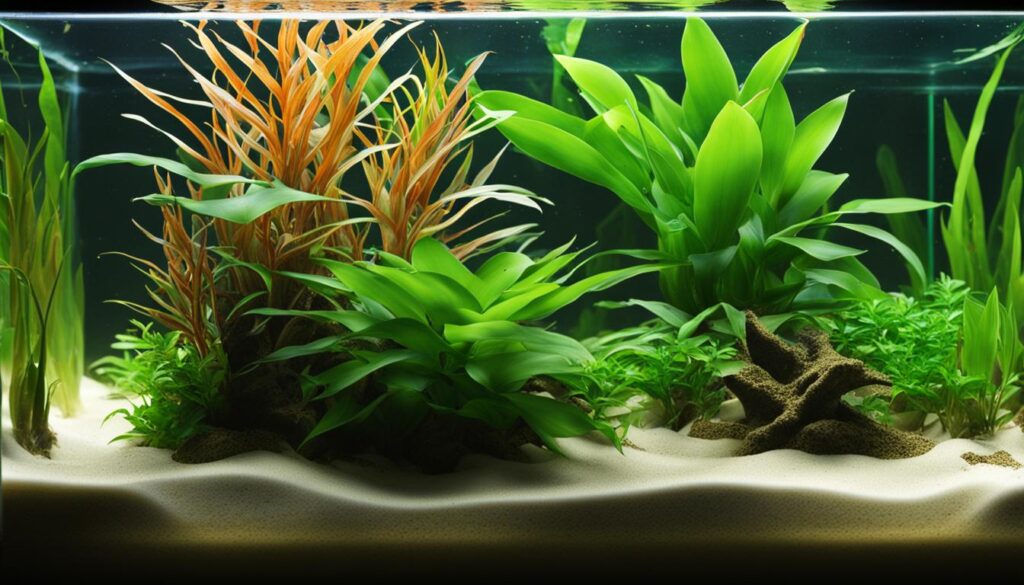
With their striking foliage and ability to thrive in sand substrates, Cryptocoryne plants are a perfect choice for creating a dynamic mid-ground area in your aquarium. Their strong roots and tolerance for various water conditions make them a versatile option for beginner and experienced aquarists alike. Add some Cryptocoryne to your sand substrate aquarium and enjoy the beauty and serenity they bring to your underwater world.
Java Moss as a Versatile Option
When it comes to plants suitable for sand substrates in aquariums, Java Moss is a versatile option that offers a range of possibilities. This hardy plant can adapt to various conditions and is known for its ability to thrive in low-light environments. Whether you want to create a lush green carpet or use it for aquascaping, Java Moss can add beauty and functionality to your sand substrate aquarium.
“Java Moss is like a playground for fish,” says aquarist Jane Smith. “It provides a natural habitat for small fry and shrimp, offering shelter and protection. It also helps to create a sense of depth and texture in the aquarium, making it visually appealing.”
One of the key advantages of Java Moss is its ability to absorb excess nutrients from the water column, which helps to prevent algae growth. It can be left to float freely in the tank, providing hiding places and breeding grounds for fish and invertebrates. Alternatively, it can be attached to driftwood or rocks, creating a tree-like structure that adds visual interest to the aquarium.
With its versatility and ease of care, Java Moss is an excellent choice for beginners and experienced aquarists alike. Its ability to adapt to different lighting conditions and water parameters makes it a hardy plant that can thrive in various setups. Whether you’re aiming for a natural-looking biotope or a more artistic aquascape, Java Moss is sure to enhance the beauty of your sand substrate aquarium.
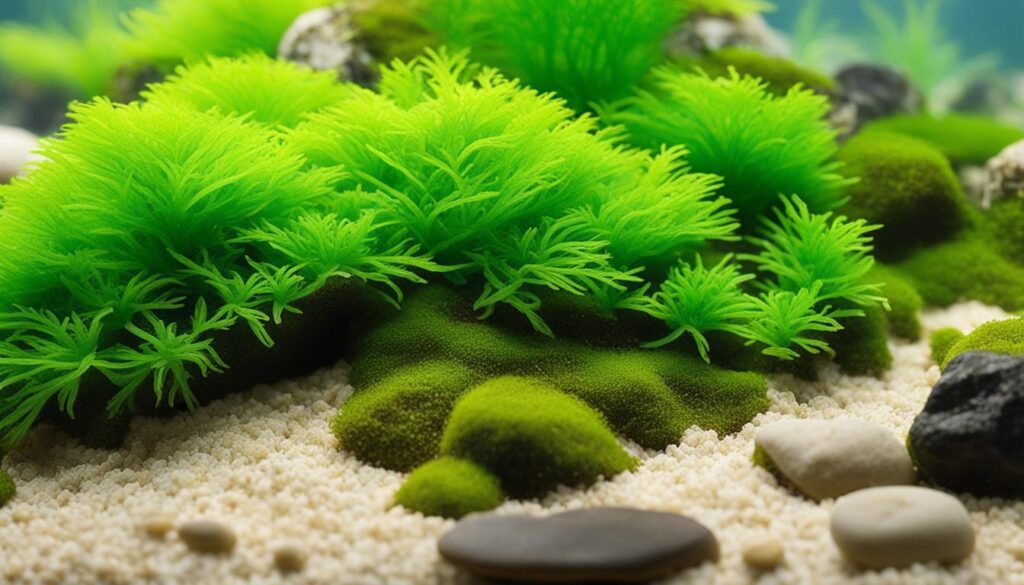
Key Features of Java Moss:
- Adaptable to various lighting conditions
- Thrives in low-light environments
- Absorbs excess nutrients, preventing algae growth
- Provides shelter and breeding grounds for fish and invertebrates
- Can be left to float or attached to driftwood/rocks
- Enhances the visual appeal of sand substrate aquariums
Quick Tips for Java Moss:
- Ensure good water circulation to prevent dead spots where debris can accumulate.
- Regularly trim and thin out Java Moss to maintain its shape and prevent it from overcrowding other plants.
- Monitor water parameters and make any necessary adjustments to maintain a stable and healthy environment for the moss.
- Consider using Java Moss as a foreground plant to create a natural look or as a backdrop to provide depth and texture to your aquarium.
| Plant Name | Lighting Requirement | Difficulty Level |
|---|---|---|
| Java Moss | Low to high | Easy |
| Water Wisteria | Low to medium | Easy |
| Anubias Nana | Low to medium | Easy |
| Hornwort | Low to high | Easy |
Live Plants in Sand Substrates
Live plants can thrive in sand substrates with the right care and conditions. While sand may not provide the same nutrient-rich environment as aqua soil, it is still possible to have a successful planted aquarium. By using root tabs, providing adequate lighting, and maintaining stable water parameters, you can create an ideal habitat for your aquatic plants.
One of the benefits of using sand as a substrate is its natural look, which can enhance the aesthetics of your aquarium. With sand, you have the flexibility to create various underwater landscapes, from sandy beaches to riverbeds. It also works well in biotope aquariums, where you aim to replicate the natural habitat of specific fish species.
When selecting plants for a sand substrate, consider those that can absorb nutrients from the water column. Some examples of easy-to-grow plants for sand substrates include Cabomba, Dwarf Hygro, Hornwort, and Java Fern. These plants have adapted to obtain their nutrients directly from the water, making them suitable for sand substrates. Remember to provide them with proper lighting, liquid fertilizer, and, if necessary, CO2 supplementation to promote optimal growth.
| Plant | Lighting requirements | Fertilizer needs | CO2 supplementation |
|---|---|---|---|
| Cabomba | Medium to high | Regular liquid fertilizer | Recommended |
| Dwarf Hygro | Medium to high | Regular liquid fertilizer | Not necessary |
| Hornwort | Low to medium | Occasional liquid fertilizer | Not necessary |
| Java Fern | Low to medium | Occasional liquid fertilizer | Not necessary |
With proper care and the right plant selection, you can enjoy a vibrant and lush planted aquarium, even with a sand substrate. Remember to provide your plants with the necessary nutrients, lighting, and stable water parameters, and your aquatic plants will thrive in their sand home.
Choosing the Right Plants for Sand Aquariums
When creating a sand aquarium, it’s crucial to choose the right plants that can thrive in this type of substrate. Selecting the appropriate plant species will ensure that your aquarium remains visually appealing and that the plants can grow and flourish. Here are some suitable options for sand aquariums:
- Amazon Swords: These plants have strong root structures and can absorb nutrients from the water column. They are ideal for background planting and provide a lush, bushy appearance.
- Java Fern: This versatile plant does not require planting in the substrate and can be attached to rocks or wood. It thrives under low light conditions and propagates easily.
- Java Moss: A highly adaptable plant, Java Moss can be used in various ways in sand substrate aquariums. It can be left to float, providing shelter for breeding fish, or attached to branches to create a tree-like structure.
- Anubias Barteri: These plants have rhizomes that can be attached to rocks or driftwood. They are low-maintenance and can tolerate a wide range of light conditions.
These plant species are well-suited for sand aquariums as they can absorb nutrients from the water column and do not heavily rely on the substrate for their growth. They will add beauty and vibrancy to your aquarium and create a natural and harmonious environment for your aquatic pets.
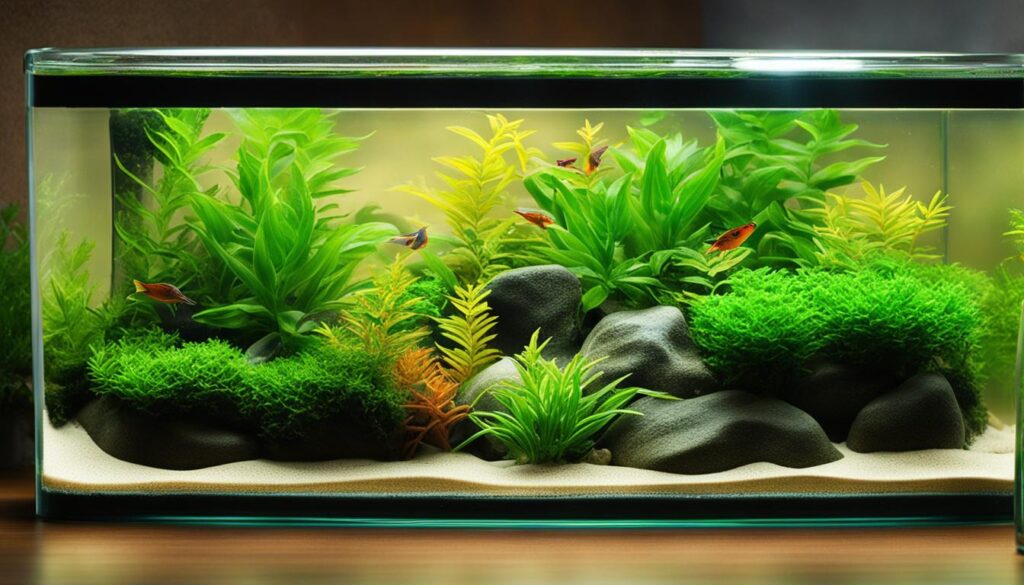
| Plant | Lighting Requirements | Fertilization Needs | Placement |
|---|---|---|---|
| Amazon Swords | Moderate to high | Root tabs recommended | Background |
| Java Fern | Low to moderate | Fertilizer not required | Foreground or attached to hardscape |
| Java Moss | Low to high | Nutrient-rich water column | Foreground or attached to hardscape |
| Anubias Barteri | Low to moderate | Minimal fertilization required | Foreground or attached to hardscape |
Tips for Planting in Sand Substrates
Proper Planting Techniques
When planting in a sand substrate, it is important to consider the unique characteristics of the substrate and take steps to promote healthy plant growth. Here are some tips to help you successfully plant in a sand substrate:
- Bury the plant roots: Unlike other substrates, sand can be challenging for plants to anchor their roots. Make sure to bury the roots deep enough to provide stability and prevent floating plants.
- Use root tabs: Since sand is not a nutrient-rich substrate, using root tabs can provide essential nutrients directly to the plant roots. These tabs can be inserted into the sand near the plants to ensure they receive the required nutrients for growth.
- Consider attaching plants to hardscape: Some plants, such as Java Fern, can be attached to rocks or wood instead of being planted directly in the substrate. This eliminates the risk of burying the roots too deeply and allows the plants to grow and attach themselves securely.
Remember to handle plants with care during the planting process to avoid damaging the delicate roots. Be gentle and take your time to ensure the plants are properly positioned in the sand substrate.
Maintenance and Care
Once the plants are properly planted in the sand substrate, it is important to provide regular maintenance and care to ensure their optimal growth. Here are some essential tips:
- Trim dead or decaying leaves: Regularly inspect the plants for any dead or decaying leaves and remove them promptly. This will prevent the spread of diseases and ensure the plants can focus their resources on healthy growth.
- Monitor nutrient levels: Since sand substrates may not provide sufficient nutrients, it is important to monitor the nutrient levels in the aquarium. Regularly test the water parameters and supplement with liquid fertilizer as needed.
- Provide adequate lighting: Plants require adequate lighting for photosynthesis and growth. Make sure to provide the appropriate lighting intensity and duration based on the specific needs of your plant species.
By following these tips and providing the necessary care, you can create a thriving planted tank in a sand substrate. With patience and proper maintenance, your plants will add beauty and vibrancy to your aquarium.
Table: Recommended Plants for Sand Substrates
| Plant Name | Lighting Requirement | Care Level | Growth Rate |
|---|---|---|---|
| Cabomba | Medium to High | Moderate | Fast |
| Dwarf Hygro | Low to Medium | Easy | Medium |
| Java Fern | Low to Medium | Easy | Slow |
| Amazon Swords | Medium to High | Moderate | Medium |
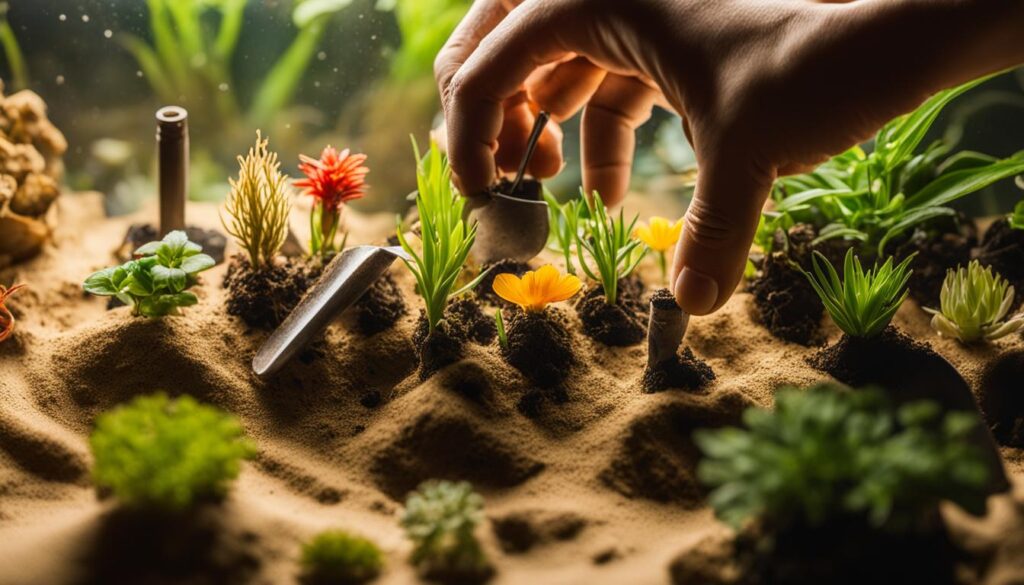
Common Challenges and Solutions
Growing plants in sand substrates can present some common challenges. It is important to address these challenges to ensure the health and vitality of your aquarium plants. Here are some of the most common challenges encountered when growing plants in sand substrates, along with their solutions:
Challenge 1: Nutrient Deficiency
One of the main challenges of growing plants in sand substrates is the lack of nutrients. Sand is not a nutrient-rich substrate, which can lead to nutrient deficiencies in plants. This can result in stunted growth, yellowing leaves, and overall poor plant health. To overcome this challenge, it is important to supplement the sand substrate with root tabs or nutrient-rich aquarium soil. These additions will provide the necessary nutrients for plant growth, ensuring healthy and vibrant plants in your aquarium.
Challenge 2: Root Anchoring Issues
Due to the density of sand, plants may face difficulties anchoring their roots and establishing a strong root structure. This can lead to plants becoming uprooted or floating in the water column. To solve this challenge, it is recommended to carefully bury the plant roots deep into the sand substrate during planting. This will help anchor the plants and promote the development of a robust root system. Additionally, providing gentle water flow in the aquarium can aid in keeping the plants rooted in the sand substrate.
Challenge 3: Melting Leaves and Transition Period
During the transition period when plants are adapting to a new sand substrate, they may experience some leaf melting. This is a normal response as the plants adjust to their new environment. To minimize leaf melting, it is essential to maintain stable water parameters and provide optimal care. This includes ensuring proper lighting, water quality, and nutrient supplementation. Regular monitoring and adjustment of care as needed will help plants overcome the transition period and promote healthy growth.
Challenge 4: Algae Growth
Another common challenge in sand substrate aquariums is algae growth. Algae can thrive in nutrient-rich environments, which can be exacerbated by excess light and nutrient imbalances. To prevent algae growth, it is important to maintain a balance between lighting, nutrient levels, and water parameters. Proper filtration, regular water changes, and the addition of algae-eating fish or invertebrates can also help control algae growth in the aquarium.
By addressing these common challenges and implementing the appropriate solutions, you can successfully grow plants in sand substrates and create a thriving and visually appealing aquarium.

How to Achieve Optimal Growth in Sand Substrates
When it comes to growing plants in sand substrates, providing the right conditions and care is essential for achieving optimal growth. While sand may lack the nutrients found in aqua soil, there are several steps you can take to ensure that your plants thrive in a sand substrate. By following these tips, you can create a beautiful and flourishing aquarium with sand as the base.
Choosing the Right Substrate
The first step in achieving optimal growth in sand substrates is selecting the right substrate for your plants. While sand may not be nutrient-rich, you can enhance its fertility by using root tabs or nutrient-rich aquarium soil. These additives will provide the necessary nutrients for your plants to establish strong root systems and grow to their full potential.
Providing Adequate Lighting
Lighting plays a crucial role in the growth of aquatic plants. Ensure that your aquarium receives the proper amount and intensity of light for the specific plants you have chosen. Use a timer to establish a consistent lighting schedule and avoid overexposure or insufficient lighting, both of which can hinder plant growth.
Supplementing with Liquid Fertilizer and CO2
In addition to the nutrients provided by the substrate, supplementing with liquid fertilizer and CO2 can significantly enhance plant growth in sand substrates. Liquid fertilizers contain essential nutrients that may be lacking in the sand, while adding CO2 can boost photosynthesis and promote robust plant growth. Be sure to follow the recommended dosage guidelines for both fertilizers and CO2 supplementation.
| Benefit | Method |
|---|---|
| Enhanced nutrient uptake | Root tabs, nutrient-rich aquarium soil |
| Healthy photosynthesis | Proper lighting, CO2 supplementation |
| Strong root establishment | Root tabs, appropriate care |
By following these recommendations, you can achieve optimal growth in sand substrates and create a vibrant underwater landscape in your aquarium. Remember to monitor water parameters, perform regular maintenance, and make adjustments as needed to keep your plants healthy and thriving.
Importance of Stable Water Parameters
Maintaining stable water parameters is essential for the health and growth of plants in sand substrates. Fluctuations in water quality can stress plants and hinder their ability to absorb nutrients from the substrate. It is crucial to monitor and adjust water parameters regularly to create a stable environment that supports optimal plant growth.
One of the most important water parameters to consider is pH. Different plant species have varying pH preferences, and maintaining the appropriate pH level is essential for their well-being. Additionally, fluctuations in pH can affect nutrient availability and hinder nutrient uptake by plants. Regular testing and adjusting of pH levels can help ensure a stable and suitable environment for plant growth.
Another crucial water parameter to monitor is water hardness. Plants have different preferences for water hardness, and maintaining the correct level is important for their growth. Soft water can lead to nutrient deficiencies, while hard water can cause mineral buildup and hinder nutrient absorption. By understanding the water hardness requirements of specific plant species and adjusting water hardness accordingly, you can create an optimal environment for their growth.
In addition to pH and water hardness, other important water parameters to consider include temperature and nutrient levels. Plants have specific temperature preferences, and maintaining stable water temperatures within their preferred range is crucial for their overall health. Nutrient levels, such as nitrogen, phosphorus, and potassium, are essential for plant growth. Regular testing and supplementation of nutrients, either through liquid fertilizers or root tabs, can help ensure that plants receive the necessary nutrients for their development.
Table: Importance of Stable Water Parameters
| Water Parameter | Importance for Plant Growth |
|---|---|
| pH | Maintaining the appropriate pH level for specific plant species is crucial for nutrient availability and uptake. |
| Water Hardness | Adjusting water hardness to suit the preferences of plant species is important for nutrient absorption and prevention of mineral buildup. |
| Temperature | Maintaining stable water temperatures within the preferred range of plants promotes overall health and growth. |
| Nutrient Levels | Regular monitoring and supplementation of essential nutrients ensure that plants receive the necessary elements for their development. |
By maintaining stable water parameters and providing the necessary conditions for plants to thrive, you can create a healthy and visually appealing aquarium with sand substrate. Regular monitoring, testing, and adjustments are key to ensuring a stable and suitable environment for plant growth. With proper care and attention to water quality, your planted tank can become a thriving ecosystem filled with lush greenery.

Conclusion
In conclusion, while growing plants in sand substrates presents challenges, it is indeed possible to have a thriving aquarium with the right care and selection of plants. By addressing the issues of nutrient deficiency and root anchoring, plants can establish themselves and flourish in a sand substrate.
Using root tabs and liquid fertilizers can provide the necessary nutrients for plant growth, while proper lighting ensures their photosynthesis process. Additionally, certain plants like Cabomba, Dwarf Hygro, Java Fern, and Cryptocoryne are well-suited for sand substrates and can absorb nutrients from the water column.
Maintaining stable water parameters, regular monitoring, and adjusting care as needed are essential to the success of plant growth in sand substrates. By following these guidelines, aquarists can create a visually stunning aquarium with live plants, adding beauty and natural balance to their aquatic environment.
FAQ
Can plants grow in sand aquariums?
Yes, plants can grow in sand aquariums, although they may face challenges due to the lack of nutrients in the substrate.
What are the challenges of growing plants in sand substrate?
The density of sand makes it difficult for plants to anchor their roots, and sand is not a nutrient-rich substrate. However, with the use of root tabs and proper care, plants can still thrive in a sand substrate.
What are the benefits of using sand as a substrate?
Sand is lighter than soil, allowing for more design versatility. It can also create a natural look in the tank, particularly in biotope aquariums. Some fish species, like Corydoras, require a sand substrate for their natural behaviors.
Do plants grow in sand substrates in nature?
Yes, many river beds have a mix of soil, gravel, and sand beneath the surface, creating a nutrient-rich environment for plant growth. In tropical locations, dry seasons lead to bare ground or grassy fields with sandy soil.
What are some easy-to-grow plants in sand substrate?
Plants like Cabomba, Dwarf Hygro, Hornwort, and Java Fern can absorb nutrients directly from the water column and thrive in a sand substrate.
What are some stem plants suitable for sand substrate aquariums?
Cabomba and Dwarf Hygro are excellent stem plants for sand substrate aquariums. Cabomba requires high lighting, CO2 supplementation, and regular liquid fertilizer dosing, while Dwarf Hygro has smaller roots that can absorb nutrients from the water column.
What are the best plants for around the aquarium?
Java Fern and Amazon Swords are popular choices for planting around the aquarium. Java Fern can be attached to rocks or wood and thrives under low light, while Amazon Swords require root tabs for optimal growth and are ideal for background planting.
What are Cryptocoryne plants suitable for?
Cryptocoryne plants are well-suited for mid-ground areas of the aquarium. They have a strong root network and rely on absorbing nutrients from the substrate.
How can Java Moss be used in aquariums with sand substrates?
Java Moss is a versatile plant that can be left to float to provide shelter for breeding fish or attached to branches to create a tree-like structure. It absorbs excess nutrients from the water column, helping to prevent algae growth.
Can live plants grow in sand substrates?
Yes, live plants can grow in sand substrates. With the use of root tabs and proper care, plants can thrive in sand substrates.
How do I choose the right plants for a sand aquarium?
When selecting plants for a sand aquarium, it is important to choose species that can thrive in sand substrates. Plants like Amazon Swords, Java Fern, Java Moss, and Anubias Barteri are suitable options.
What are some tips for planting in sand substrates?
When planting in a sand substrate, it is important to bury the plant roots and use root tabs if necessary. Some plants, like Java Fern, can be attached to rocks or wood, eliminating the need for substrate planting. Regular maintenance, such as trimming and removing dead leaves, is also important.
What are some common challenges when growing plants in sand substrates?
Common challenges when growing plants in sand substrates include nutrient deficiency, root anchoring issues, and melting leaves during the transition period. The use of root tabs, liquid fertilizer, and proper lighting can help overcome these challenges.
How do I achieve optimal growth in sand substrates?
Optimal growth in sand substrates can be achieved by providing the proper care and conditions for plants. This includes using root tabs or nutrient-rich aquarium soil, adequate lighting, liquid fertilizer, and CO2 supplementation if necessary. Regular maintenance, such as pruning and removing decaying leaves, will promote healthy growth.
Why are stable water parameters important for plant growth in sand substrates?
Maintaining stable water parameters is crucial for the health and growth of plants in sand substrates. Regular water testing and changes, along with proper filtration and temperature control, help create a stable and suitable environment for plant growth.
